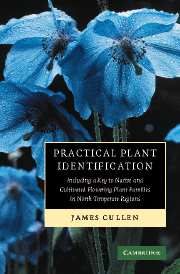 Practical Plant Identification
Practical Plant Identification Book contents
- Frontmatter
- Contents
- List of illustrations
- Preface
- Acknowledgements
- Introduction
- Examining the plant: a brief survey of plant structure and its associated terminology
- Using the keys
- Keys
- ‘Spot’ characters
- Arrangement and description of families
- Further identification and annotated bibliography
- Glossary
- Index
Introduction
Published online by Cambridge University Press: 02 December 2009
- Frontmatter
- Contents
- List of illustrations
- Preface
- Acknowledgements
- Introduction
- Examining the plant: a brief survey of plant structure and its associated terminology
- Using the keys
- Keys
- ‘Spot’ characters
- Arrangement and description of families
- Further identification and annotated bibliography
- Glossary
- Index
Summary
The family is one of the ranks of the taxonomic system, as developed by plant taxonomists over the past two hundred years, that is important in the accurate identification of plants. In fact, it is the first stage (leaving aside the distinction between dicotyledons and monocotyledons) in the process of using the taxonomic hierarchy for the purposes of of identification. Identification means the finding of the correct name for an unknown plant, not as an end in itself, but as a means of access to all the information so far available about that plant. This is the primary purpose of the taxonomic system; later uses of this system, such as that purporting to show evolutionary relationships among the various taxa (phylogeny), are secondary and frequently not particularly helpful in the achieving of the primary aim.
In the flowering plants (Angiospermae), the number of families (often also called natural orders before 1905) was originally quite small (A. L. de Jussieu's Genera plantarum of 1789 contained exactly 100 families, although the precise significance of this number is not known), and the original idea was that all of the families could be known by a single person. Further developments in taxonomy, dependent on the increasing exploration of the world and its plants, showed that this small number was untenable and that more families would have to be recognised.
- Type
- Chapter
- Information
- Practical Plant IdentificationIncluding a Key to Native and Cultivated Flowering Plants in North Temperate Regions, pp. 1 - 4Publisher: Cambridge University PressPrint publication year: 2006
